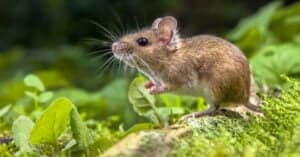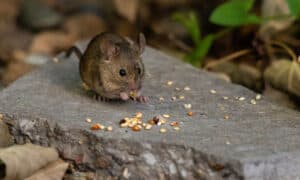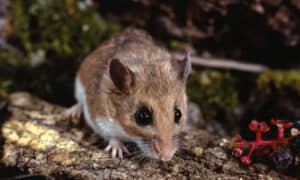When most people hear the word “gerbil,” their first thoughts are likely of the little, adorable rodents that make lovely pets. But aside from their status as furry and fun companions, what else can we say about these tiny creatures? One key factor to consider is their sleep habits. Are gerbils nocturnal, or diurnal? The answer may surprise you. They are neither entirely nocturnal nor diurnal. Instead, they exhibit crepuscular and metaturnal behaviors. Follow along to gain a deeper understanding of the gerbil’s sleep behavior.
Gerbil Species
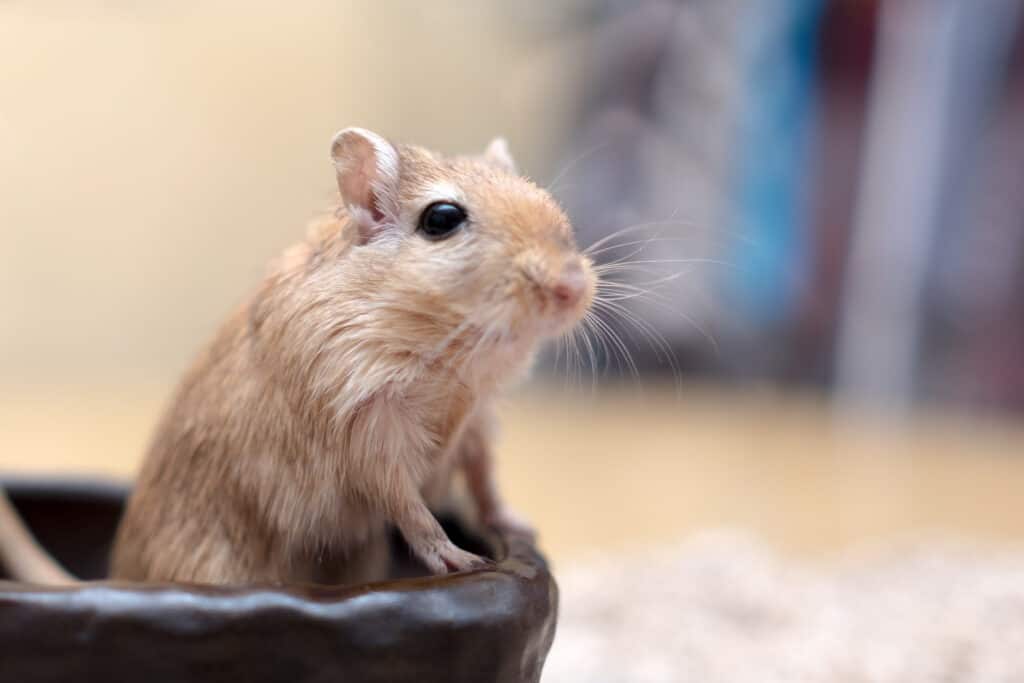
Gerbils are neither diurnal nor crepuscular, but they are, in fact, metaturnal.
©iStock.com/Skyimages
Gerbil species (over 100) come in various shapes, sizes, and behaviors. Of all the gerbil species that people keep as pets, two of the most common are Mongolian gerbils and Fat-tailed gerbils. The Mongolian gerbil is a small, friendly animal with fluffy fur and round black eyes. On the other hand, the Fat-tailed gerbil is larger and more athletic, with shorter hair and smaller ears. Both species are popular with pet owners due to their gentle natures and easy-going dispositions.
Other interesting gerbil species include:
- Shaw’s Jird: They have a long tail for balance when running.
- Pallid Gerbils: They have pale fur that helps them blend into their desert habitats.
- Great Gerbils: These are larger gerbils with long legs designed for digging.
- North African Gerbils: They have skin flaps on their ears that protect them from blowing sand.
- Tamarisk Jirds: They have silky coats and timid natures.
- Guinean gerbils: They have soft brown fur and inquisitive dispositions.
Metaturnal (Not Nocturnal) Gerbil Sleep Pattern During 24 Hours
As anyone who has spent time with gerbils can attest, these beloved little rodents are champion sleepers. On average, they spend around 12 hours each day sleeping. Sleeping for half a day is a long time, but understandable given how much energy they expend during their waking hours. Whether scampering around in the wild or eating food and playing with toys in their cages as pets, gerbils burn many calories every day.
Their high activity habits mean they need plenty of rest to recover and refuel. Despite their tendency to sleep for such long periods, gerbils do not nap for more than a few hours at a time. Their napping schedule typically consists of one to four-hour naps spread throughout the day and night. This irregular sleep pattern is typical of metaturnal animals.
Nocturnal vs Diurnal vs Crepuscular vs Metaturnal
In case you were wondering what each of these terms means, have a quick squizz below, so you know what we mean when talking about the gerbil’s sleeping behavior:
- Nocturnal – Primarily active at night.
- Diurnal – Busiest during the day.
- Crepuscular – Active during low light periods like dusk and dawn.
- Metaturnal – Animals with these sleep patterns nap throughout the 24-hour cycle, whether night or day.
Age Regarding Amount of Sleep
When it comes to gerbil sleep habits, age can play a significant role. Baby gerbils tend to sleep more than adults since their brains and bodies are still growing and developing. Growth takes a lot of energy, so they need extra rest to compensate for their maturation. For young adults, establishing a healthy sleep routine often takes some time.
Elderly gerbils are also more likely to spend more time sleeping than younger animals. This behavior is natural, as their bodies start to slow down with age, and they require more rest to compensate for this decline in energy. Gerbils might begin showing signs of aging around two or three years old. At most, a gerbil’s lifespan is about four years.
Factors Influencing Gerbil Sleep Behavior

There are over 100 gerbil species, all needing regular metaturnal naps throughout the day.
©Jearu/Shutterstock.com
Many believe gerbils are strictly diurnal or nocturnal creatures, meaning they are most active during the day or night. However, this belief is not entirely true. It is common for wild gerbils to be most active either at night or during the day, or a combination, depending on environmental factors. On the other hand, scientists have discovered captive gerbils exhibit some metaturnal and crepuscular behavior. This behavior means their natural sleep patterns are disturbed by being in different environments.
In addition to this fascinating finding, research also reveals that a gerbil’s sleeping patterns vary depending on the season or time of year. For example, in winter, gerbils typically sleep more than in summer. This sleep schedule may help to conserve energy in colder temperatures. Whether you are a pet owner or fascinated by these fascinating creatures, it is clear that gerbils are highly adaptable animals with unique tendencies regarding their sleeping patterns.
Gerbil Sleeping Positions
Concerning sleeping positions, gerbils have a unique approach that depends on their surroundings. Gerbils typically sleep on their backs with their legs in the air if the temperature exceeds 86 degrees Fahrenheit. They tend to lie on their sides at lower temperatures, between 77 and 85 degrees Fahrenheit. And if the temperature drops below 77 degrees or becomes very hot, gerbils will often tuck their heads between their rear legs to keep warm or cool off as needed. Gerbils have a sophisticated approach to sleep that adapts to ensure their comfort and well-being at all times. So whether they are primarily active at night does not mean they are nocturnal. It implies that gerbils sleep in short bursts and ensure they’re comfortable when they nap.
Co-Sleeping Behavior
When it comes to gerbils, one thing is clear, these little rodents love to bond and sleep on top of each other. They often build intricate nests out of hay, grass, and other materials where they happily curl up together in a tight group. However, there is an important reason for this behavior.
Firstly, baby gerbils are surprisingly vulnerable to cold weather and food shortages. Having extra insulation from the ground and each other can make all the difference to their survival. So, when you see a cluster of gerbils piled together in their cozy nest, remember that it’s not only for convenience or comfort. It is also a crucial part of their strategy for staying warm and thriving as a species.
Gerbil Eye Structure and Sight: Nocturnal or Not?
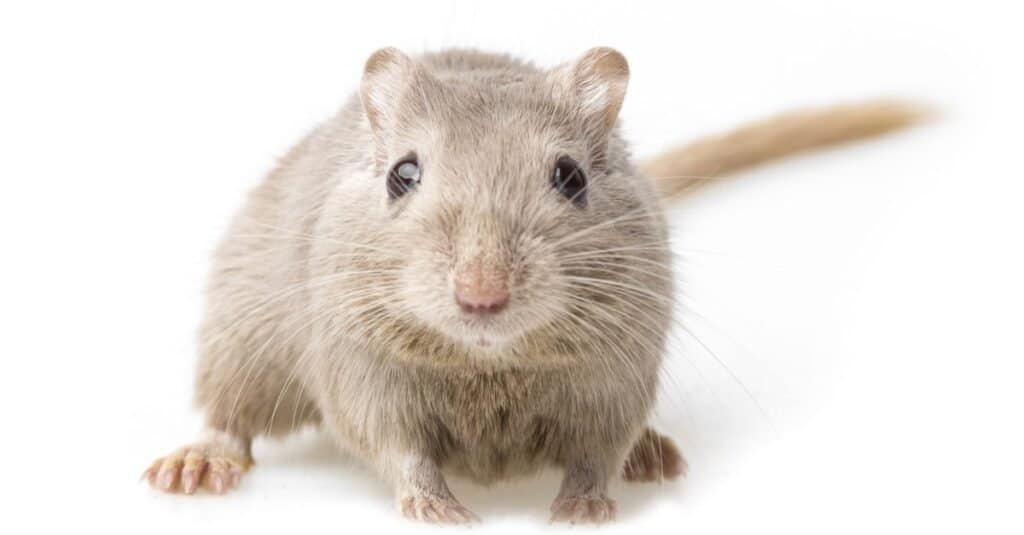
Although gerbils are primarily active at night, they are not nocturnal, but their
sleep patterns vary depending on their habitats
.
©Kuttelvaserova Stuchelova/Shutterstock.com
The structure of the gerbil’s eyes plays a crucial role in its ability to see in brightly lit and dim environments. Unlike nocturnal rodents, such as mice and rats, that rely on rod cells for good vision, gerbils’ eyesight differs. Gerbils have a more cone-based vision than other rodents and a smaller percentage of rods than most other rodents. This phenomenon suggests that while gerbils can see color to some degree, they may be colorblind in the red-green spectrum.
However, their eye structure allows them to take advantage of their daily activity cycles. Additionally, their retinas are densely packed with cells, providing adequate visual sensitivity even under low lighting conditions.
Overall, the unique eye structure of gerbils contributes to their remarkable ability to see well in any setting. Whether foraging or exploring their environment during the day or night, gerbils can rely on their sharp vision to help them get the most out of each waking moment.
Nocturnal vs. Diurnal: What’s The Difference?
Navigate to Nocturnal vs. Diurnal: What’s The Difference? for further information about the nocturnal and diurnal phenomenon in various living creatures.
Up Next –
- What Do Gerbils Eat?
- Gerbil vs. Mouse: Key Differences Explained
- The Best Gerbil Cage for a Happy Pet for 2022
- Hamster vs. Gerbil: 4 Key Differences Explained
The photo featured at the top of this post is © iStock.com/Devonyu
Sources
- ScienceDirect, Available here: https://www.sciencedirect.com/science/article/abs/pii/S155878781830220X
- Research Gate, Available here: https://www.researchgate.net/publication/8062515_Lamina_formation_in_the_Mongolian_gerbil_retina_Meriones_unguiculatus
- (1970)
- (1970)
- (1970)
Thank you for reading! Have some feedback for us? Contact the AZ Animals editorial team.



